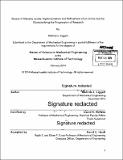| dc.contributor.advisor | David R. Wallace. | en_US |
| dc.contributor.author | Liggett, Melinda L. (Melinda Lois) | en_US |
| dc.contributor.other | Massachusetts Institute of Technology. Department of Mechanical Engineering. | en_US |
| dc.date.accessioned | 2015-04-08T18:02:50Z | |
| dc.date.available | 2015-04-08T18:02:50Z | |
| dc.date.copyright | 2014 | en_US |
| dc.date.issued | 2014 | en_US |
| dc.identifier.uri | http://hdl.handle.net/1721.1/96462 | |
| dc.description | Thesis: S.M., Massachusetts Institute of Technology, Department of Mechanical Engineering, 2014. | en_US |
| dc.description | Cataloged from PDF version of thesis. | en_US |
| dc.description | Includes bibliographical references (pages 36-37). | en_US |
| dc.description.abstract | Technology Readiness Levels are used in industry to help allocate resources, plan research and development, and clarify communication. Research Maturity Levels, proposed by Ming Leong in 2011, are designed to bring these same benefits to the academic research community. At its inception, the RML framework was accessible by a paper survey, and administrators of the survey could provide a visualization of research progress to respondents of the survey. In order to develop the survey as a helpful tool, the RML Framework was developed into an online tool. This enabled automatic visualizations and greater access to the framework. Discussed in this paper are the design of and findings from the online tool for the RML Framework. For the tool to be useful, it must reflect the process of academic research, and the output from it can help researchers plan and communicate their work. Therefore, improvement of the tool falls into two broad categories: refinement of input (researchers translating their work to the tool), and refinement of output (researchers understanding that the tool says about their work). Interviews with researchers using the tool has lead to refinements including fewer difficulty levels for maturity levels, and inputting research impediments in comparison to one another instead of on absolute scales. Asking researchers about how and with whom they would disseminate tool data has led to proposed visualizations including long term research "shape" and short term comparisons between levels of progress. The next steps in developing the Research Maturity Levels framework are implementing these changes and additions, monitoring how the tool is used, and interviewing researchers who use the tool for further improvements. | en_US |
| dc.description.statementofresponsibility | by Melinda L. Liggett. | en_US |
| dc.format.extent | 68 pages | en_US |
| dc.language.iso | eng | en_US |
| dc.publisher | Massachusetts Institute of Technology | en_US |
| dc.rights | M.I.T. theses are protected by copyright. They may be viewed from this source for any purpose, but reproduction or distribution in any format is prohibited without written permission. See provided URL for inquiries about permission. | en_US |
| dc.rights.uri | http://dspace.mit.edu/handle/1721.1/7582 | en_US |
| dc.subject | Mechanical Engineering. | en_US |
| dc.title | Research maturity levels : implementation and refinement of an online tool for characterizing the progression of research | en_US |
| dc.title.alternative | Implementation and refinement of an online tool for characterizing the progression of research | en_US |
| dc.type | Thesis | en_US |
| dc.description.degree | S.M. | en_US |
| dc.contributor.department | Massachusetts Institute of Technology. Department of Mechanical Engineering | |
| dc.identifier.oclc | 905973655 | en_US |
